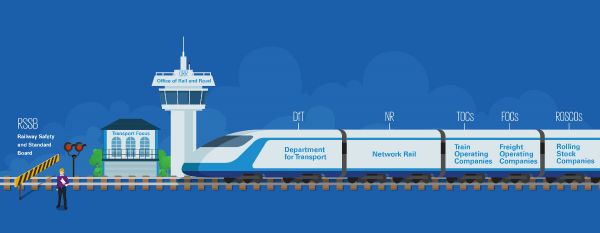

Away from the volatile spotlight of Bitcoin and other cryptocurrencies is the distributed ledger system that allows these digital economies to function. Blockchain is about trust and transparency – and features prominently as an important technology and innovation trend that can support the United Kingdom's digital railway strategy.
Blockchain is already being deployed in complex transport environments. For example, the world's largest retailer Walmart recently patented its "Smart Package" system – a Blockchain-based tracking tool that logs package contents, environmental conditions, location, and other important data points across its vast network. In April, Bloomberg heralded that "Blockchain is about to revolutionize the shipping industry" while the FT published "Supermarkets, pig farmers and cotton traders turn to Blockchain", both hinting at the vast potential of the ledger technology for coordinating and linking together supply chains and other symbiotic corporate relationships working together in complex industries.
Stripping out the complexities and arriving to its core purpose, Blockchain automates processes and records transactions (or interactions) in a distributed ledger system that verifies the results and is inherently resistant to modification – resulting in increased trust, transparency and productivity.
The concept has broad potential and an ability to revolutionize the UK rail industry, some examples of which include:
• Automating passenger delay and cancelation compensation schemes by linking digital payments to customer journeys (via smartphone applications like TravelAI) to real-time network service timetables without any required actions from the passengers themselves
• Automating delay repayments between Network Rail, Train Operating Companies (TOCs) and Freight Operating Companies (FOCs)
• Managing large flows of information between different stakeholders involved in large scale infrastructure project delivery and management for seamless and undisrupted operations of train services
• Managing supply chain during rolling stock manufacturing and assembly
• Providing streamlined – and where possible spontaneous – passenger feedback and rectification
• Managing revenue allocation
Railways are built for mass connectivity. It's slightly ironic then that the supply chain behind these networks are often not fully connected when it comes to operations and information flows. This creates inefficiency impacting financial performance and day-to-day operation delivery; which in turn affects reputation and the negative public perceptions associated with delays, cancelations, failures and lack of resources.
The railway landscape in the UK has many active players – making it not only the world's oldest network (nearly 200 years) but also one of the most complex in terms of ownership, operations and management structure.

Adding to this complexity, the UK railway network has been under increasing pressure from numerous stakeholders facing four key challenges:
1) Ageing infrastructure and rolling stock
2) Increasing demand and the lack of matching capacity
3) Punctuality and provision of services
4) Expensive to use, run and maintain
All of the above are connected and somewhat consequential to one another. This should come as an advantage as orderly confrontation of these issues could assist in unblocking other barriers.
Network Rail's route entities and affiliated supply chains are working day and night to address ageing infrastructure and lack of capacity by way of maintenance, enhancement, renewals and new facilities. These activities are already targeted and proactive – but having Blockchain underpin the information flows will dramatically improve the coordination of business activities allowing the TOCs and FOCs to efficiently adjust in real-time, communicate better with end users and run services that meet increasing demand and punctuality expectations.
The objective is to move businesses away from the status quo – reactive 'firefighting' – to more proactive (and coordinated) management of information across the supply chain allowing industry leaders to focus more on building the digital railways of the future.
Improved infrastructure capacity does not automatically address the capacity shortfall that passengers experience. TOCs need more rolling stock to meet the demand, the lack of which impacts the provision of services. While there is already some alignment in the industry – using a Blockchain to manage information and performance autonomously would have tangible organizational and financial benefits.
It could also impact passenger experience. All TOCs in the UK have to comply with passenger delay and cancellation compensation schemes. These schemes not only require passengers to actively seek out and complete online forms to be compensated, but they can also create a significant amount of administrative work for the operators. To address this, Automatic Delay Repay schemes have been set up by some TOCs for those passengers that have experienced delays of 30 minutes or more to their journey, given that those passengers have booked an "Advanced" ticket through the TOC's website. By combining Blockchain and smart ticketing technologies, a greater proportion of passengers could be automatically compensated whenever trains are delayed / canceled regardless of ticket type or payment method. It also facilitates the potential for new pricing models such as compensating people for standing on congestion trains (for example).
The UK railway network has historically demonstrated a progressive attitude for talking about innovation – if not adopting it. Blockchain provides the next logical evolution of the sector's complex operating model – providing the building blocks for creative operations, better stakeholder connectivity, collaboration and engagement. Moreover, the transparency and access to information across the entire supply chain will enable a more systematically connected railway.
In order to achieve this vision, there needs to be clear sponsorship from regulators and industry leaders establishing standards and a level of authority that injects necessary protocols, governance, security and controls are in place. This is largely to ensure that data is secure, processes are recorded / maintained / executed correctly across the supply chain in the context of a targeted, interactive and appropriate sharing platform.
Blockchain is not just for Bitcoin and cryptocurrency – it is far, far more. We believe this technology is ready for the UK rail industry. And given the challenges the sector faces – as well as its ambitions – it is almost as if the excitement Blockchain is creating elsewhere is building to crescendo in the UK's digital rail strategy.


